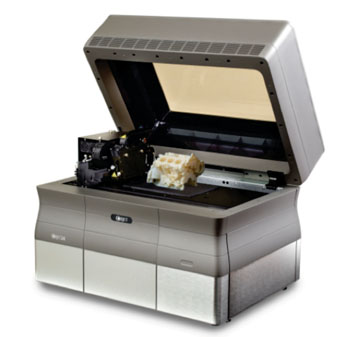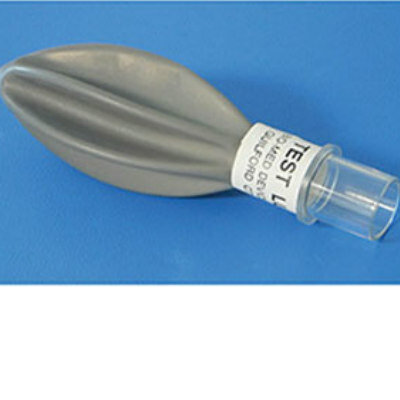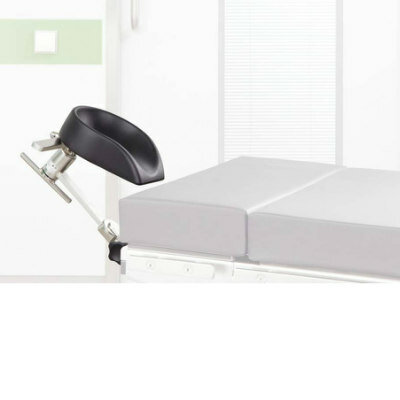3D Printers Deployed in 12 UK hospitals 
|
By HospiMedica International staff writers Posted on 17 Sep 2014 |

Image: The Stratasys Objet24 Pro 3D printer (Photo courtesy of Stratasys).
3D printers convert CT scans to 3D model as surgical guides in NHS Hospitals.
Stratasys (Rehovot, Israel) 3D printers have been installed in 12 National Health Service (NHS; London, United Kingdom) hospitals to support the validation of patient surgery prior to an operation.
The printers will be supplied by Replica 3DM (Salisbury, United Kingdom), which was first established as a three dimensional (3D) modeling department of Salisbury District Hospital. The company has now extended its medical 3D printing capabilities to NHS hospitals across the United Kingdom. The deployment includes Stratasys Objet24 and Objet30 Pro 3D printers, which will convert patient computerized tomography (CT) scans into physical printed models for use as presurgical guides.
The 3D printed models will help surgical teams in the re-bending of titanium implant plates to the patient's exact specifications, thus eliminating potential problems during operations. The models can also be used as a visual aid when explaining the surgical procedure to patients. Other benefits include preoperative investigations across maxillofacial, orthopedics, neurology, spinal and ears, nose and throat wards, to identify the correct procedure. The use of the printers will also help reduce surgical procedure times, which in turn could lead to an overall decrease in theatre costs.
“To us, 3D printing and the medical profession go hand-in-hand, particularly in the planning of complicated procedures. A 3D model equips surgeons with a hands-on perspective which cannot be achieved by looking at a computer screen,” said Matthew Sherry, managing director and founder of Replica 3DM. “They can easily rotate, inspect and analyze each surgical procedure on a case-by-case basis, enabling them to pre-bend implants knowing that they will perfectly fit the patient.”
“In an industry where precision is paramount, the ability to produce highly accurate 3D printed surgical models and guides that mimic the look and feel of titanium implants can both lower costs and reduce the time required for patients to be anesthetized,” added Chris Baker, Northern European territory manager at Stratasys. “As a result, an increasing number of hospitals worldwide are integrating 3D printing into surgical planning procedures, which is having an immediate positive impact on the quality of patient treatment.”
Related Links:
Stratasys
National Health Service
Replica 3DM
Stratasys (Rehovot, Israel) 3D printers have been installed in 12 National Health Service (NHS; London, United Kingdom) hospitals to support the validation of patient surgery prior to an operation.
The printers will be supplied by Replica 3DM (Salisbury, United Kingdom), which was first established as a three dimensional (3D) modeling department of Salisbury District Hospital. The company has now extended its medical 3D printing capabilities to NHS hospitals across the United Kingdom. The deployment includes Stratasys Objet24 and Objet30 Pro 3D printers, which will convert patient computerized tomography (CT) scans into physical printed models for use as presurgical guides.
The 3D printed models will help surgical teams in the re-bending of titanium implant plates to the patient's exact specifications, thus eliminating potential problems during operations. The models can also be used as a visual aid when explaining the surgical procedure to patients. Other benefits include preoperative investigations across maxillofacial, orthopedics, neurology, spinal and ears, nose and throat wards, to identify the correct procedure. The use of the printers will also help reduce surgical procedure times, which in turn could lead to an overall decrease in theatre costs.
“To us, 3D printing and the medical profession go hand-in-hand, particularly in the planning of complicated procedures. A 3D model equips surgeons with a hands-on perspective which cannot be achieved by looking at a computer screen,” said Matthew Sherry, managing director and founder of Replica 3DM. “They can easily rotate, inspect and analyze each surgical procedure on a case-by-case basis, enabling them to pre-bend implants knowing that they will perfectly fit the patient.”
“In an industry where precision is paramount, the ability to produce highly accurate 3D printed surgical models and guides that mimic the look and feel of titanium implants can both lower costs and reduce the time required for patients to be anesthetized,” added Chris Baker, Northern European territory manager at Stratasys. “As a result, an increasing number of hospitals worldwide are integrating 3D printing into surgical planning procedures, which is having an immediate positive impact on the quality of patient treatment.”
Related Links:
Stratasys
National Health Service
Replica 3DM
Channels
Critical Care
view channel
Wearable Patch for Early Skin Cancer Detection to Reduce Unnecessary Biopsies
Skin cancer remains one of the most dangerous and common cancers worldwide, with early detection crucial for improving survival rates. Traditional diagnostic methods—visual inspections, imaging, and biopsies—can... Read more
Pulse Oximeter Index Offers Non-Invasive Guides for Fluid Therapy
In patients with acute circulatory failure, deciding whether to administer intravenous fluids is often a life-or-death decision. Too little fluid can leave organs underperfused, while too much can cause... Read moreSurgical Techniques
view channel
Robotic Assistant Delivers Ultra-Precision Injections with Rapid Setup Times
Age-related macular degeneration (AMD) is a leading cause of blindness worldwide, affecting nearly 200 million people, a figure expected to rise to 280 million by 2040. Current treatment involves doctors... Read more
Minimally Invasive Endoscopic Surgery Improves Severe Stroke Outcomes
Intracerebral hemorrhage, a type of stroke caused by bleeding deep within the brain, remains one of the most challenging neurological emergencies to treat. Accounting for about 15% of all strokes, it carries... Read morePatient Care
view channel
Revolutionary Automatic IV-Line Flushing Device to Enhance Infusion Care
More than 80% of in-hospital patients receive intravenous (IV) therapy. Every dose of IV medicine delivered in a small volume (<250 mL) infusion bag should be followed by subsequent flushing to ensure... Read more
VR Training Tool Combats Contamination of Portable Medical Equipment
Healthcare-associated infections (HAIs) impact one in every 31 patients, cause nearly 100,000 deaths each year, and cost USD 28.4 billion in direct medical expenses. Notably, up to 75% of these infections... Read more
Portable Biosensor Platform to Reduce Hospital-Acquired Infections
Approximately 4 million patients in the European Union acquire healthcare-associated infections (HAIs) or nosocomial infections each year, with around 37,000 deaths directly resulting from these infections,... Read moreFirst-Of-Its-Kind Portable Germicidal Light Technology Disinfects High-Touch Clinical Surfaces in Seconds
Reducing healthcare-acquired infections (HAIs) remains a pressing issue within global healthcare systems. In the United States alone, 1.7 million patients contract HAIs annually, leading to approximately... Read moreBusiness
view channel
Philips and Masimo Partner to Advance Patient Monitoring Measurement Technologies
Royal Philips (Amsterdam, Netherlands) and Masimo (Irvine, California, USA) have renewed their multi-year strategic collaboration, combining Philips’ expertise in patient monitoring with Masimo’s noninvasive... Read more
B. Braun Acquires Digital Microsurgery Company True Digital Surgery
The high-end microsurgery market in neurosurgery, spine, and ENT is undergoing a significant transformation. Traditional analog microscopes are giving way to digital exoscopes, which provide improved visualization,... Read more
CMEF 2025 to Promote Holistic and High-Quality Development of Medical and Health Industry
The 92nd China International Medical Equipment Fair (CMEF 2025) Autumn Exhibition is scheduled to be held from September 26 to 29 at the China Import and Export Fair Complex (Canton Fair Complex) in Guangzhou.... Read more














